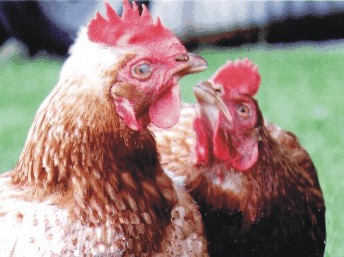|
|
An explanation - Free range hens do not always use the nice nesting boxes you thoughtfully provide for them and choose to lay eggs wherever they please, making you search for them. One clutch was found in the straw meant for the goats in one of the stalls of the old milking parlour, hence the caption. We began keeping chickens over a year ago with some Buff Orpingtons. We had been bought a chicken shed soon after the foot & mouth outbreak began and with this came some chickens. We quickly learnt that that allowing them the full range of the property was not without problems, not the least of which is foxes. We soon lost a chicken or two to the fox because we were unaware that one gate they could get through, only allowed them to get one way. They were trapped in a neighbouring field too far from safety. After this first disaster we borrowed a fox trap but when the owner told us that the foxes would not go near it for several weeks because it would small of human contact, we wondered if there was not another way of deterring foxes. Chickens do not range that far and by walking around the perimeter of where they roamed. Just the human scent would deter them. It lasted for a while but soon they fox got bolder and was twice seen, in broad daylight, first walking boldy amongst all the sheep with a rat in its mouth but eventually taking a chicken only yards from people working. We never did catch a fox in the trap even though it had been bated with one of the abandoned carcasses. We did not replace those first hens with pedigree Orpingtons until we had learnt a bit more about their welfare. Last September we spotted an advert for ex-barn reared free range hens at 50p each. They were close to the end of their egg laying life at about 18 months but we thought that at least we could give them a good retirement home if they layed a few eggs for us. If you think 18 months is a bit short for egg laying then I should explain that ISA Browns are a hybrid bred to lay the maximum number of eggs for a short period. These "free range" hens probably did pass the criteria for the title but if this means they must have access to an outside run of a certain size then perhaps the definition should also say that this run should be at ground level. Their two story barn included a second story balcony of wire mesh so the droppings good fall through but where they got to scratch for grubs and eat grass is another matter? It is the grass they eat that makes the yolks yellow. Most hens are given a feed that includes a colouring to make the yolks yellow! We bought 8 chickens and for many weeks they gave 6-7 eggs per day. Then another management error meant we lost most again and had to restock. All the hens were extremely tame and would rush up to you and peck at you legs. They would follow you into neighbouring field to clear the ground where you might have been digging, often only just getting out of the way before being dug into the soil or planted with a fence post. The second batch stayed with us for many months, right up to the point where the stopped laying and their future became uncertain. It was interesting to note that we didn't have a problem with foxes while there was no hunting during the foot & mouth epidemic. Once the hunting began again they became a problem as the hunt moved foxes from their normal area. I hadn't planned to mention this except that a local farmer wrote in the local paper that in his many years experience he had found the same. It is two of this last batch shown above. We were unsure what to do. We had cruelly been leaving them out in the hope that fate would intervene and a fox would dispatch them. Weeks passed but with no luck or bad luck if you were a chicken. We then had pangs of guilt and decided we should let a professional do the job and began shutting them up again. Then sod's law took over. On the one night we were unable to get back in time to shut them up we returned in the dark and actually caught the fox in their shed. Trapped for quite a while, he eventually leaped onto a manger on one wall and from there onto the top of a dividing wall. The fox must have reallised there was quite a drop the other side but eventually he dropped about eight feet into the darkness. Some weeks later we were given a mix of six hens to test out our new hen house (The Flat Pack Chicken Shack) but unfortunatley we lost all but two of these in the mistaken belief that the run was now fox-proof. The two remaining would roost high in the roof of the building out of harms way. We are now left with a single chicken called 'lucky' who roosts above one of the horses, probably for extra warmth. After several weeks with Lucky still roosting in Bright's stable but not laying, we find a clutch of five eggs. Guess where? In the straw in with the goats. There must be something special about that spot as Lucky is now giving us at least one egg a day and on one occasion laid two in the space of about three hours. She must have forgiven us but we must get her some companions. We now have two very small but seperate flocks. Scotts Dumpy's - one hen and one cockerel rearing a mixed batch of 3 chicks. Barnevelders - One large cockerel, two hens and a Black Rock hen that's been with us for nearly five years. |

